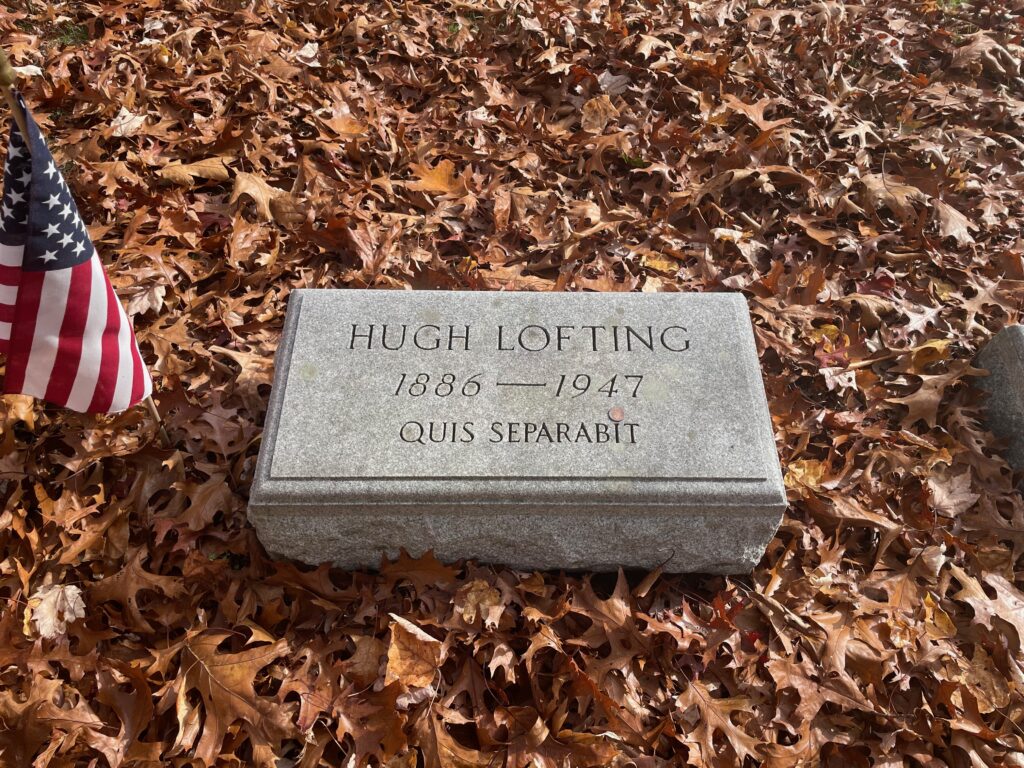Erik Visits an American Grave, Part 1,407
This is the grave of Hugh Lofting.

Born in 1886 in Maidenhead, Berkshire, England, Lofting grew up fairly well off in a family that would spawn a lot of success. In fact, his brother Hilary later became a fairly prominent novelist in Australia. Well, Hugh went to British colleges, but came over in 1905 to study engineering at MIT, already a fine institution. He married in 1912, had some kids, traveled around a good bit, did his work. In World War I, he enlisted in the Irish Guards. He was part Irish, which explains that. He saw some nasty stuff, as did nearly everyone.
So here you have this guy and he has a family and he’s lonely. He can’t really write home to kids and explain to them how he saw these people gassed or dead with bodies eaten by rats or whatever. So instead, he started making up stories to tell them. His letters became more and more stories for children. He then got shot. So he was pretty severely wounded and came home.
In 1919, partly to recover from his injuries and to just get a fresh start, he and his family moved to Connecticut. By this time, Lofting was spending most of his time writing. He took the stories he told his children in his war letters and started creating a book out of them. This, as many of you have already surmised, is Doctor Doolittle. He published his first book, the awkwardly titled The Story of Doctor Doolittle: Being the History of His Peculiar Life at Home and Astonishing Adventures in Foreign Parts Never Before Printed in 1920. It did very well and encouraged Lofting to publish more. By the time he published the sequel, 1922’s far better titled The Adventures of Doctor Doolittle, his books were an international sensation. That second book won the Newberry the next year, only the second year that now august award for best children’s book existed.
This now become an internationally important series. Doctor Dolittle’s Post Office followed in 1923, Doctor Dolittle’s Circus in 1924, and Doctor Dolittle’s Caravan in 1926. Five novels followed that, as well as bunches of stories. In all of these stories, the combination of a doctor having global adventures and talking animals made for child wanting gold. Of course the films followed, though not for awhile, long after Lofting’s death. Rex Harrison played the doctor in the first adaptation, in 1967. Then there was the Eddie Murphy adaptations in the late 90s. Robert Downey Jr. played the role in 2020. But in fact the first adaptation was a 1928 German silent cartoon by Lotte Reiniger, one of the real pioneers of animated film.
Lofting’s other children’s books were relatively popular, but not nearly like the Doctor Doolittle series. The Story of Mrs Tubbs from 1923 and Tommy, Tilly, and Mrs. Tubbs from 1936 were attempts to reach into the little kid market with picture books. Porridge Poetry has retained a good bit of popularity as you don’t see a lot of poems for children, or at least it’s not something I’m familiar with, though mercifully I don’t need to be. Noisy Nora from 1929 is about a girl who eats too loud. I don’t imagine this translates well into cultures where noisy eating is a sign of the food being good, particularly in Asia. Then he went for the older reading group–high schoolers I guess, with The Twilight of Magic, which was about the last days of magic being dominant in the world before the scientific revolution. All of his books were illustrated, including this one.
In 1942, Lofting finally decided to deal with his war experiences. He wrote a long poem, explicitly for adults, called Victory for the Slain. It was a weird time for a strongly pacifist poem. Lofting might have lived in Connecticut, but he was very British and his writings reflected that. This poem was only published in Britain, at the very moment the British were fighting for the nation’s future against the Nazis. It was completely ignored at the time, though it is considered an important work of anti-war literature today.
Lofting also was a massive drinker. Not sure whether it was the war injuries and experiences or just the generation, but like a lot of writers of this generation, he drank himself into the grave. In his case, it was in 1947 when he was outside of Los Angeles. He was 61 years old.
Hugh Lofting is buried in Evergreen Cemetery, Killingsworth, Connecticut.
If you would like this series to visit other Newberry Award winners, you can donate to cover the required expenses here. Charles Finger, who won in 1925 for Tales from Silver Lands, is in Farmington, Arkansas and Arthur Bowie Chrisman, who won in 1926 for Shen of the Sea, is in White Post, Virginia. Previous posts in this series are archived here and here.
